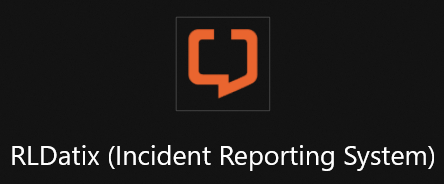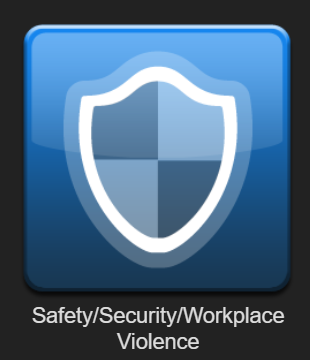“At UC Davis Health, aggressive behavior is not tolerated toward or from anyone, including patients, visitors, volunteers, physicians and/or staff members.”
Reminder: Contact 911 in case of emergency
How to Report Workplace Violence
Staff who witness or are involved in a workplace violence event should report it to:
- Unit supervisor/manager
- Security and/or UCDPD
- Submit online incident report through RLDatix
- How to submit an incident report in RLDatix:
1. Click on the "RLDatix (Incident Reporting System)" icon on a desktop computer

2. Scroll down to the second row from the bottom, and click on the "Safety/Security/Workplace Violence" icon
A blank incident report will appear.
3. Submit direct quotes and specific actions when possible.
E.g. State, "patient called me a b*itch and swung his arm at my head", rather than, "patient was verbally and physically aggressive".
4. You will receive an email from the Workplace Violence Prevention Unit to confirm your submission.- How to Place an FYI:
- While in the patient's chart, select "FYI" (can be found in the search bar if it is not already part of your menu).
Once you select "FYI", you will see a drop down menus. Select "History of violent behavior"
Enter the date and write direct quotes and specific actions when possible, rather than writing generalized statements. For example, state, "patient called me a b*tch and swung his arm at my head" rather than saying, "patient was verbally and physically aggressive".
Select "Accept" once you are finished typing.
The patient's chart will be flagged with a red "history of violent behavior" warning, which will automatically pop up each time the patient's chart is opened.
UC Davis Health Trainings
New Hire RN Training Requirement
Effective August 1, 2023, all incoming new employee RNs will complete Nonviolent Crisis Intervention training.
All Trainings
More trainings can be found here.
About Workplace Violence and Tools
- California Code of Regulations Title 8 Section 3342- Violence Prevention in Health Care
- The Joint Commission Workplace Violence Standards
- When and How to Submit an Incident Report and Place an FYI for Violent Behavior
- What is "Workplace Violence"?
“Workplace Violence” is defined as "any act of violence or threat of violence [directed towards an employee] that occurs at the worksite.” It does not include “lawful acts of self-defense or defense of others.” Workplace violence includes the following:
“The threat or use of physical force against an employee that results in, or has a high likelihood of resulting in, injury, psychological trauma, or stress, regardless of whether the employee sustains an injury.”
“An incident involving the threat or use of a firearm or other dangerous weapon, including the use of common objects as weapons, regardless of whether the employee sustains an injury.”
A "threat of violence" means "a statement or conduct that causes a person to fear for his or her safety because there is a reasonable possibility the person might be physically injured.
- What is The Joint Commission's "Workplace Violence" definition?
- On January 1, 2022, The Joint Commission released New and Revised Requirements for Workplace Violence Prevention: “An act or threat occurring at the workplace that can include any of the following: verbal, nonverbal, written, or physical aggression; threatening, intimidating, harassing, or humiliating words or actions; bullying; sabotage; sexual harassment; physical assaults; or other behaviors of concern involving staff, licensed practitioners, patients, or visitors.”
- What are the Cal/OSHA "Workplace Violence" Reporting Requirements?
There is a narrower set of criteria for reporting workplace violence incidents to Cal/OSHA. In general terms, a workplace violence incident is reportable if it involved:
1. "The use of physical force against an employee by a patient or a person accompanying a patient that resulted in, or had a high likelihood of resulting in, injury requiring more than first aid or psychological trauma or stress"
2. "An incident involving the use of firearm or other dangerous weapon" (regardless of the classification of the perpetrator)Additionally, Cal/OSHA requires all reportable incidents to be submitted within either a 24-hr. or a 72-hr. time frame. Incidents must be reported within 24 hrs. if they involve a fatality, hospitalization over 24 hours for other than observation, loss of limb, serious degree of permanent disfigurement, the use of firearm/dangerous weapon, or a threat to the safety/health/welfare where death or serious harm could result. Any other incident that meets the reporting requirements must be reported within 72 hrs.
Tools
- Workplace Violence Checklist
- FYI Moderate Risk
- FYI High Risk Precautions
- Abuse Not Tolerated Signage
- Management of a Planned Potentially Violent Encounter (PPVE)
- UC Davis Health Workplace Violence Prevention Plan for Fiscal Year 2025-2026
- UC Davis Workplace Violence Prevention Annual Report
UC Davis Policy Links
- UCDH policy 1616- Violence and Hate Incidents in the Workplace
- UCDH policy 1649- Incivility and Bullying in the Workplace
- UCDH policy 4067- Prevention and Management of Violence by a Patient or Visitor
- Abusive Conduct in the Workplace